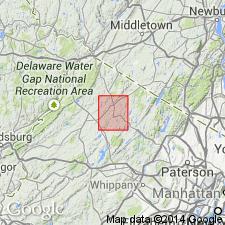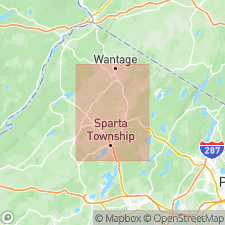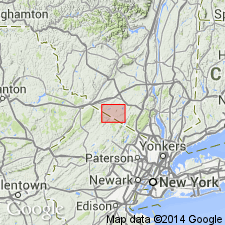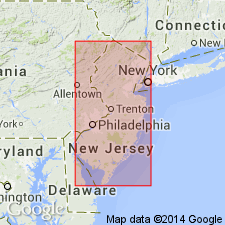
- Usage in publication:
-
- Franklin white limestone*
- Modifications:
-
- Named
- Dominant lithology:
-
- Limestone
- AAPG geologic province:
-
- Appalachian basin
Summary:
Pg. 431-456. Franklin white limestone. Coarsely crystalline rock, frequently containing graphite in disseminated scales. Is typically white, but often has a bluish tinge. Is pre-Cambrian, and older than Hardistonville [Hardyston] quartzite.
[Named for occurrence at Franklin Furnace, NJ.]
Source: US geologic names lexicon (USGS Bull. 896, p. 772).

- Usage in publication:
-
- Franklin limestone*
- Modifications:
-
- Overview
- AAPG geologic province:
-
- Appalachian basin
Summary:
Franklin limestone. White, highly crystalline limestone or marble, varying greatly from place to place in texture and composition, and to less degree in color. As a rule coarsely granular, but some of rock is finely granular or even nearly amorphous. Color usually milky white, but locally it has a pink or yellow tinge and elsewhere it is grayish. Some of it is rather siliceous, and in a few places thin beds of sandstone have been noted. Unconformably underlies Hardyston quartzite and Kittatinny limestone. Although Pochuck gneiss and Franklin limestone are regarded as older than Byram and Losee gneisses, which appear to cut them, the original relations between them are not determinable. In Franklin Furnace area the Pochuck gneiss passes beneath Franklin limestone.
Source: US geologic names lexicon (USGS Bull. 896, p. 772).

- Usage in publication:
-
- Franklin limestone*
- Modifications:
-
- Overview
- AAPG geologic province:
-
- Appalachian basin
Summary:
The name Franklin limestone is now [ca. 1938] restricted to the white limestone to which it was originally applied. The associated siliceous rocks (formerly in large part included in Pochuck gneiss) are now regarded as older than Franklin limestone and are by definition included in Pickering gneiss, although in places some siliceous rocks are so intimately associated with the limestone that they are not readily separable from it and for convenience are mapped with the limestone. The Franklin limestone was formerly classified by the USGS as Archean, but, that term having been discarded, the formation is now classified as pre-Cambrian.
Source: US geologic names lexicon (USGS Bull. 896, p. 772).

- Usage in publication:
-
- Franklin Marble*
- Modifications:
-
- Redescribed
- Dominant lithology:
-
- Marble
- AAPG geologic province:
-
- Appalachian basin
Summary:
Franklin Limestone of Spencer and others (1908) is here redescribed as Franklin Marble because the rock is marble and is revised to include only the Franklin band of marble (Hague, J.M., Baum, J.L., Herrmann, L.A., and Pickering, R.J., 1956, Geology and structure of the Franklin-Sterling area, N.J.: GSA Bull., v. 67, no. 4, p. 435-474). The Wildcat band of marble (Hague and others, 1956) was originally mapped with the Franklin Limestone by Spencer and others (1908) but is here removed from the revised Franklin and formally designated the Wildcat Marble. [Wildcat was erroneously described as a formal name in Bulletin 1200.] Wildcat is separated from the Franklin by the Cork Hill gneiss zone. Through most of the area it is represented by a single band of marble, generally indistinguishable from Franklin band (Hague and others). Unconformably overlies Losee Metamorphic Suite and charnockitic rocks of NJ Highlands; unconformably underlies lower Paleozoic sedimentary rocks. Age is Middle Proterozoic.
Source: GNU records (USGS DDS-6; Reston GNULEX).

- Usage in publication:
-
- Franklin Marble
- Modifications:
-
- Areal extent
- Overview
- AAPG geologic province:
-
- Appalachian basin
Summary:
Marble is widespread but is best exposed west of the Green Pond Mountain region. Especially abundant in the Wawayanda, Hamburg, Franklin, Blairstown, and Belvidere quadrangles. Most is white to light gray, medium- to coarse-crystalline, massive to moderately layered, calcitic to locally dolomitic rock. Other pods, lenses, and layers of marble in the Highlands east of the Green Pond Mountain region are spatially associated with the same lithologies as the marble in the Franklin area. Therefore, at this time, all marble is tentatively correlated with the Franklin, although not all marble in the Highlands occurs at the same stratigraphic level. All workers agree that the marble is a metamorphosed limestone and lesser dolomitic limestone that contains pods, lenses, and layers of calcareous and quartzose metasedimentary rocks, amphibolite, and metaquartzite. Galena collected in Ogdensburg from a marble "dike" has yielded a lead age of 1100 Ma and is naturally younger than the marble or gneiss that surrounds it, thus providing a minimum age for the Franklin.
Source: GNU records (USGS DDS-6; Reston GNULEX).
For more information, please contact Nancy Stamm, Geologic Names Committee Secretary.
Asterisk (*) indicates published by U.S. Geological Survey authors.
"No current usage" (†) implies that a name has been abandoned or has fallen into disuse. Former usage and, if known, replacement name given in parentheses ( ).
Slash (/) indicates name conflicts with nomenclatural guidelines (CSN, 1933; ACSN, 1961, 1970; NACSN, 1983, 2005, 2021). May be explained within brackets ([ ]).

